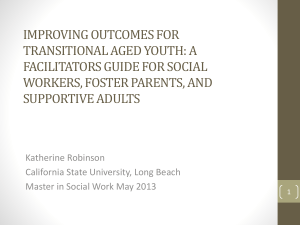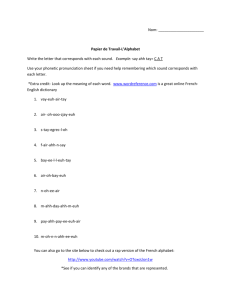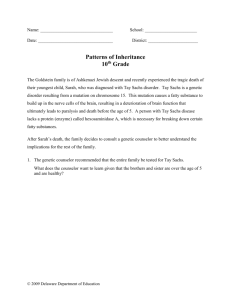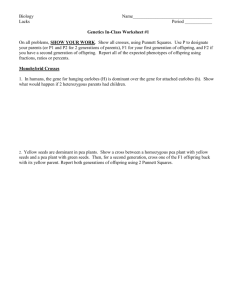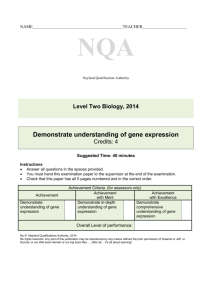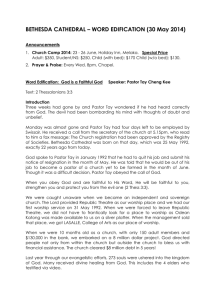Optimality Theory And WORD ORDER CHANGE IN ENGLISH
advertisement
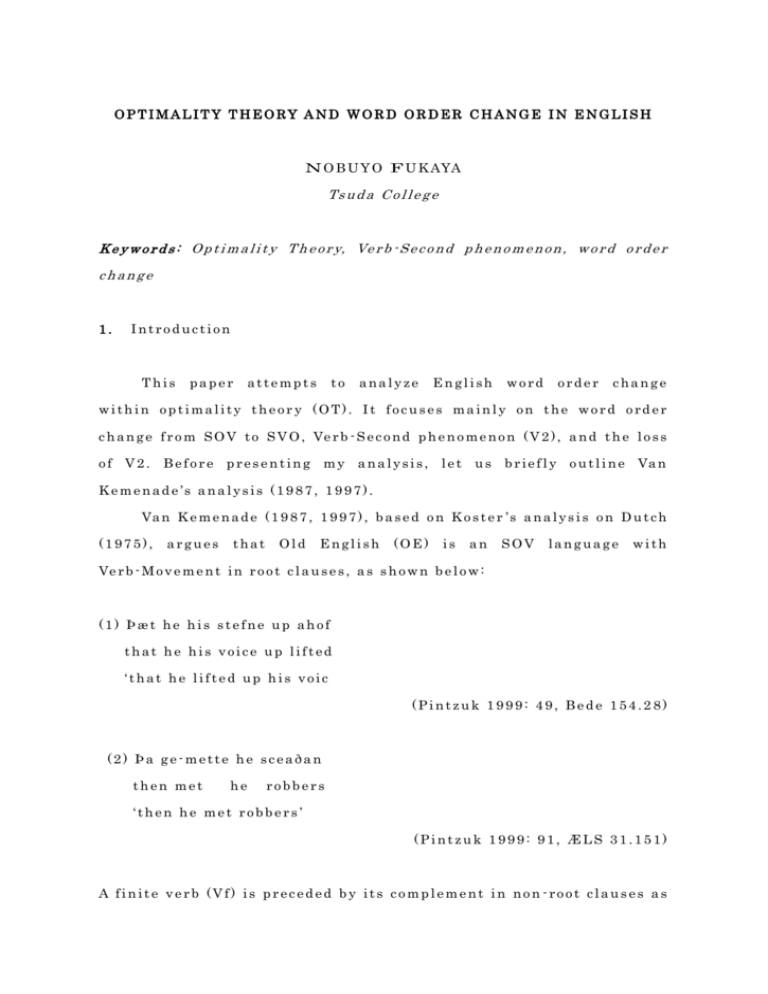
OPTIMA LITY THEORY A ND WOR D OR DER C HANGE IN E NGLISH
N O B U Y O F U K AYA
Ts u d a C o l l e g e
K e y w o r d s : O p t i m a l i t y T h e o r y, Ve r b - S e c o n d p h e n o m e n o n , w o r d o r d e r
change
1.
Introduction
This
paper
attempts
to
analyze
English
word
order
change
within optimality theory (OT). It focuses mainly on the word order
c h a n g e f r o m S O V t o S V O , Ve r b - S e c o n d p h e n o m e n o n ( V 2 ) , a n d t h e l o s s
o f V 2 . B e f o r e p r e s e n t i n g m y a n a l y s i s , l e t u s b r i e f l y o u t l i n e Va n
K e m e n a d e ’s a n a l y s i s ( 1 9 8 7 , 1 9 9 7 ) .
Va n K e m e n a d e ( 1 9 8 7 , 1 9 9 7 ) , b a s e d o n K o s t e r ’ s a n a l y s i s o n D u t c h
(1975),
argues
that
Old
English
(OE)
is
an
SOV
language
with
Ve r b - M o v e m e n t i n r o o t c l a u s e s , a s s h o w n b e l o w :
(1) Þæt he his stefne up ahof
that he his voice up lifted
‘that he lifted up his voic
(Pintzuk 1999: 49, Bede 154.2 8)
(2) Þa ge-mette he sceaðan
then met
he
robbers
‘then he met robbers’
(Pintzuk 1999: 91, ÆLS 31.151)
A finite verb (Vf) is preceded by its complement in non -root clauses as
in example (1). In root clauses as shown in example (2), V f appears as
the second constituent of the clause, regardless of the grammatical
function of the initial constituent.
Va n
Kemenade
(1987,
1997)
states
that
there
occurred
two
important structural changes in Middle English (ME): the underlying
word order change from SOV to SVO and the loss of V2. Let us look at
t h e m i n d i v i d u a l l y.
The
underlying
word
order
change
from
SOV
to
SVO
was
completed by 1200. Illustrative examples of a non -root clause and a
r o o t c l a u s e a r e g i v e n i n ( 3 ) a n d ( 4 ) , r e s p e c t i v e l y. N o t e , h o w e v e r, t h a t
V2 was still alive, so that the movement of Vf to the head of CP was
required in root clauses.
(3) gif Þet tu wilnest were Þe muche wlite habbe
if that you desire man that much beauty have
‘If you want a beautiful husband ’
( Va n K e m e n a d e 1 9 8 7 : 1 7 9 , H M , 2 0 . 8 )
(4) Þa ge-mette he sceaðan
then met
he
robbers
‘then he met robbers’
(Pintzuk 1999: 91, ÆLS 31.151)
The second change relevant to English word order in ME is the
loss of V2, which took place around 1400. This is shown in (5):
(5) Sothely Þe ryghtwyse sekys Þe Ioye and …
truly
the righteous seeks the joy and …
‘ Tr u l y t h e r i g h t e o u s s e e k s t h e j o y a n d … ’
( Va n K e m e n a d e 1 9 8 7 : 1 8 2 , R R , 4 ,
24)
In example (5) with the topic sothely, the verb sekys does not occupy
the second position of the clause.
This paper is organized as follows: in section 2, I introduce six
relevant constraints to analyze the word order change from SOV to
SVO, V2, and its loss. Secti on 3 shows how OT analyzes these word
order changes. Section 4 draws a conclusion.
2.
The relevant constraints
In order to account for the word order changes indicated above, I
will introduce the following six constraints:
The first constraint that is relevant here is TP -SCOPE:
(6) TP-SCOPE: A topic must move to the position that c -commands the
entire sentence.
The function of this constraint is to force a topic specified in the
input1 to move into the initial position of a clause.
The second constraint is TP -SPEC:
(7) TP-SPEC: A topic that is specified in the input must move to a
specifier position.
M o r e p r e c i s e l y, T P - S P E C r e q u i r e s a t o p i c s p e c i f i e d i n t h e i n p u t t o
move to [Spec, CP], since [Spec, IP] has already been occupied by a
s u b j e c t a n d [ S p e c , V P ] m u s t b e s a v e d f o r c h e c k i n g , a s s h o w n i n ( 11 )
below:
The
OB-HD:
third
constraint
that
plays
an
important
role
here
is
(8) OB-HD: A projection has a head.
(Grimshaw 1997: 374)
T h e f o u r t h c o n s t r a i n t i s S TAY, t h e f u n c t i o n o f w h i c h i s t o f o r b i d
movement:
( 9 ) S TAY: Tr a c e i s n o t a l l o w e d .
(Grimshaw 1997: 374)
The fifth constraint works in non -root clauses as shown below:
(10) PURE-EP: No adjunction takes place to the highest node in a
subordinate extended projection; and no movement
takes place into the highest head of a subordinate
extended projection.
(Grimshaw 1997: 374)
T h e s i x t h a n d t h e l a s t c o n s t r a i n t i s S AT I S F Y:
( 11 )
S AT I S F Y:
Morpho-syntactic
features
must
be
checked
in
a
specifier position.2
(Speas 1997: 176)
This constraint forces a complement of Vf to move to [Spec, VP] for
checking. According to Speas (1997), all phrases are base -generated
h e a d - i n i t i a l l y. T h e i n t e r a c t i o n b e t w e e n S AT I S F Y a n d S TAY d e c i d e s
whether a head precede its complement or not in a language. I will
assume, following Speas (1997), that a complement is always preceded
by a head in its base - position and demonstrate that the wor d order
change from SOV to SVO completed by 1200 can be attributed to
reranking of the constraints.
3.
An analysis of English word order change within OT
3.1
An account of non-root clauses
Having introduced the relevant constraints, let us consid er how
t h e c o n s t r a i n t s i n t e r a c t w i t h e a c h o t h e r. I b e g i n m y e x p l o r a t i o n b y
analyzing the word order change from SOV to SVO observed clearly in
non-root clauses and then turn to V2 and its loss in root clauses.
3.1.1
Old English
Let us first analyze OE non-root clauses using the four relevant
c o n s t r a i n t s : O B - H D , S TAY, P U R E - E P, a n d S AT I S F Y. T h e c o n s t r a i n t s
TP-SCOPE
and
TP-SPEC
are
not
relevant
here,
since
all
of
the
candidates vacuously satisfy them. Suppose that OE has the following
ranking:
( 1 2 ) P U R E - E P, S AT I S F Y > > S TAY > > O B - H D
I n r a n k i n g ( 1 2 ) , P U R E - E P a n d S AT I S F Y a r e e q u a l l y r a n k e d , w h i c h
o u t r a n k S TAY, w h i c h i s i n t u r n u n d o m i n a t e d b y O B - H D . T h e p a r t i a l
r a n k i n g o f S AT I S F Y o v e r S TAY i m p l i e s t h a t i t i s m o r e i m p o r t a n t t o
move
a
complement
of
Vf
to
[Spec,
VP]
than
to
prohibit
such
movement. The following tableau of the sentence Þæt he his stefne up
a h o f d e m o n s t r a t e s t h e c o r r e c t n e s s o f r a n k i n g ( 1 2 ) . Ta b l e a u ( 1 3 ) s h o w s
the key competitors:
(13)
Þæt ({up ahof(x,y), x=he, y=
his stefne, tense=past})
PUREEP
S AT I S F Y
a. ☞[ CP Þæt [IP he e [VP his
stefnei up ahof ti]]]
b. [CP Þæt [IP he ahofj [VP his
stefnei up tj ti]]]
c. [ CP Þæt [IP he e [VP
ahof his stefne]]]
Candidate
(a)
has
OBHD
*
*
**
*!
up
violations
S TAY
of
S TAY
*
and
OB -HD,
since
the
complement his stefne moves to [Spec, VP] and the head of IP is not
f i l l e d . T h e t w o v i o l a t i o n s , h o w e v e r, p r o v i d e t h e b e s t w a y t o s a t i s f y t h e
top-ranked constraints.
Candidate (b), with the movements of the
c o m p l e m e n t a n d V f t o [ S p e c , V P ] a n d t h e h e a d o f I P, r e s p e c t i v e l y,
v i o l a t e s S TAY t w i c e . C a n d i d a t e ( c ) , w h e r e n o e l e m e n t s m o v e , p e r f e c t l y
r e s p e c t s S TAY. T h i s c a n d i d a t e , h o w e v e r, f a t a l l y v i o l a t e s S AT I S F Y.
Ta b l e a u ( 1 3 ) c o r r e c t l y s e l e c t s c a n d i d a t e ( a ) w i t h t h e l e a s t s e r i o u s
violations as optimal.
3.1.2
Early Middle English
Let us turn to non-root clauses in Early Middle English (EME).
B a s e d o n Va n K e m e n a d e ’ s a n a l y s i s ( 1 9 8 7 , 1 9 9 7 ) , t h e b a s e c h a n g e f r o m
SOV to SVO was completed by 1200, as example (3) illustrates. Given
this analysis, ranking (12) is considered to have changed as in (14):
( 1 4 ) P U R E - E P, S TAY > > S AT I S F Y, O B - H D
I n r a n k i n g ( 1 4 ) , P U R E - E P a n d S TAY a r e t i e d , d o m i n a t i n g S AT I S F Y
a n d O B - H D . T h e p a r t i a l r a n k i n g o f S TAY o v e r S AT I S F Y p r e d i c t s t h a t
a
complement
of
Vf
would
occupy
its
underlying
position.
The
correctness of this ranking is shown in tableau (15):
(15)
gif
Þet({wilnian(x,y), x tu,
were Þe muche wlite
habbe,
tense=present
y=
PURE
-EP
subjunctive })
a. [CP gif Þet [IP tu e [VP
were Þe muche wlite habbei
wilnest ti]]]
b.
[CP
gif
Þet
[IP
tu
wilnestj[VP were Þe muche
wlite habbei
tj ti]]]
c. ☞ [CP gif Þet [IP tu e[VP
wilnest were Þe muche wlite
habbe]]]
S TAY
S AT I S F Y
*!
OBHD
*
*!*!
*
*
Ta b l e a u ( 1 5 ) r i g h t l y s e l e c t s c a n d i d a t e ( c ) w i t h S V O o r d e r a n d t h e
least serious violations as optimal.
3.2
An OT account of root clauses
Having demonstrated that the word order change from SOV to
SVO observed mainly in non -root clauses was caused by reranking of
(12) to (14), let us turn to V2 and the loss of V2 in root -clauses using
the
five
constraints,
TP -SCOPE,
TP-SPEC,
OB-HD,
S TAY,
and
S AT I S F Y. 3
3.2.1
Old English
Suppose that in OE the five constraints are ranked as in (16):
( 1 6 ) T P - S C O P E , T P - S P E C , O B - H D , S AT I S F Y > > S TAY
S TAY i s d o m i n a t e d b y t h e f o u r c o n s t r a i n t s , w h i c h a r e t i e d w i t h e a c h
o t h e r. Wi t h t h e r e v e r s e r a n k i n g , a n y m o v e m e n t w o u l d b e b l o c k e d b y
S TAY. Ta b l e a u ( 1 7 ) i l l u s t r a t e s r a n k i n g ( 1 6 ) :
(17)
{gemetan
(x,y),
z=topic,
x=he,
y=
sceaðan,
z=Þa,
tense=past}
a.
☞
[CP
Þai
ge-mettej[IP he tj [VP
sceaðank tj tk ti]]]
b.
[CP
Þai
ge-mettej[IP he tj [VP
tj sceaðan ti ]]]
c. [CP Þai e[IP he
gemettej [VP sceaðank
tj tk ti]]]
d. [IP Þai [IP he e[VP
gemette sceaðan ti]]]
e. [CP Þai e[IP he e [VP
gemette sceaðan ti]]]
TP-SC
OPE
TP-SP
EC
OBHD
S AT I S F Y
S TAY
****
*!
***
*!
*!
***
*!
*!
*
*!*!
*!
*
C a n d i d a t e ( a ) i n v o l v e s f o u r S TAY v i o l a t i o n s , s i n c e t h e t o p i c Þ a , t h e
verb ge-mette and the complement sceaðan move to their respective
p o s i t i o n s . S u c h v i o l a t i o n s , h o w e v e r, h a v e t h e b e n e f i t o f s a t i s f y i n g t h e
higher-ranked
remains
in
constraints.
situ,
has
one
Candidate
(b),
wher e
S AT I S F Y
and
three
the
complement
S TAY
violations.
C a n d i d a t e ( c ) l a c k s t h e h e a d o f C P, r e s u l t i n g i n o n e O B - H D a n d t h r e e
S TAY v i o l a t i o n s . C a n d i d a t e ( d ) s a t i s f i e s T P - S C O P E b y a d j o i n i n g t h e
t o p i c t o I P, b u t i t f a t a l l y v i o l a t e s T P - S P E C , O B - H D , a n d S AT I S F Y.
Candidate (e) respects TP -SPEC and TP-SCOPE by moving the topic to
[Spec, CP], but incurs two OB -HD violations due to the lack of the
h e a d s o f I P a n d C P. Ta b l e a u ( 1 7 ) d e m o n s t r a t e s t h a t c a n d i d a t e ( a ) i s a
winner and the others are all losers under the ranking in (16).
A c t u a l l y, c a n d i d a t e ( a ) i s g r a m m a t i c a l i n O E g r a m m a r.
3.2.2
Early Middle English
L e t u s t u r n t o E M E r o o t c l a u s e s . N o t e , h o w e v e r, t h a t t h e s u r f a c e
structure of root clauses in EME is the same as that in OE. Compare
example (2) in OE and example (4) in EME. Both of them have the
following schematic structure, with the topic in the initial position
([Spec, CP]) and Vf in the second position (the head of CP). (18)
leaves out traces to simplify exposition:
(18) [CP topic Vf [IP subject
[VP
complement]]]
This comes from the fact that the word order change from SOV to SVO
does not directly affect the loss of V2 that had existed after 1200.
Thus, the movement of Vf to the head of CP masks the interaction
b e t w e e n S AT I S F Y a n d S TAY. I a s s u m e , f o l l o w i n g Va n K e m e n a d e ( 1 9 8 7 ,
1997), that example (2) and example (4) have different structures by
analogy with non-root clauses shown in examples (1) and (3). Given
this
assumption,
the
ranking
in
(16)
can
be
considered
to
have
changed by 1200 to the following:
( 1 9 ) T P - S C O P E , T P - S P E C , O B - H D > > S TAY > > S AT I S F Y
I n E M E , S TAY i s r a n k e d o v e r S AT I S F Y, w h i c h i s t h e r e v e r s e r a n k i n g
of the one proposed for OE. The following tableau shows how a
grammatical sentence is chosen as optimal:
(20)
{ahof
up(x,y),
z=topic,
x=Pauls,
y=his heafod, z= Þa,
tense=past}
a. [CP Þai ahofj [IP
Paulus
tj
[VP his
heafodk tj up tk ti]]]
b. ☞ [CP Þai ahofj [IP
Paulus tj [VP tj up
his heafod ti]]]
c. [CP Þai e [IP Paulus
ahofj [VP his heafodk
tj up tk ti]]]
d. [IP Þai [IP Paulus
e[VP
ahof up his
heafod ti]]]
e.
[CP Þai e [IP
Paulus e[VP ahof up
his heafod ti]]]
TP-SCO
PE
TP-SP
EC
OBHD
S TAY
S AT I S F Y
****
***
*!
*
*!
***
*!
*
*
*!*!
*
*
As tableau (20) shows, candidate (b), where the complement stays in
situ, is optimal in EME.
3.2.3
Late Middle English
Let us examine root clauses in Late Middle English (LME).
A c c o r d i n g t o Va n K e m e n a d e ( 1 9 8 7 , 1 9 9 7 ) , V 2 w a s l o s t b y 1 4 0 0 , a s
example (5) shows. It follows that ranking (19) was reranked as in
(21) by 1400:
( 2 1 ) T P - S C O P E > > S TAY > > O B - H D , S AT I S F Y > > T P - S P E C
I n r a n k i n g ( 2 1 ) , T P - S C O P E d o m i n a t e s S TAY, s o t h a t a t o p i c m o v e m e n t
i s r e q u i r e d . T P - S P E C a n d O B - H D a r e , h o w e v e r, d o m i n a t e d b y S TAY.
Thus, a topic cannot move to [Spec, CP], contrary to OE and EME
grammars. The following tableau illustrates this:
(22)
{sekys(x,y),
z=topic,
x= Þe ryghtwyse, y=
Þ e I o y e , z = s o t h e l y,
tense=present}
a.
[CP
Sothelyi
sekysj[IP
Þe
ryghtwyse tj [VP
Þe
Ioyek tj tk ti]]]
b. [CP Sothelyi sekysj
[IP Þe ryghtwyse tj
[VP tj Þe Ioye ti]]]
c. [CP Sothelyi e[IP Þe
ryghtwyse sekys j [VP
Þe Ioyek tj tk ti]]]
d. ☞ [IP Sothelyi [IP
Þe ryghtwyse e [VP
sekys Þe Ioye ti]]]
e. [CP Sothelyi e[IP Þe
ryghtwyse e[VP sekys
Þe Ioye ti]]]
TP-SCO
PE
S TAY
OBHD
S AT I S F Y
TP-SP
EC
****
***
*
***
*
*
*
*
*
**
*
*
Candidate (d) with the topic sothely adjoined to IP is optimal in LME.
This results in the loss of V2.
4.
Conclusion
This paper has analyzed the word order changes within OT and
illustrated
the
applicability
of
OT
to
historical
syntax.
I
have
proposed that in non-root clauses, OE and EME have the rankings in
( 1 2 ) a n d ( 1 4 ) , r e s p e c t i v e l y. T h e r a n k i n g s l e a d u s t o t h e c o n c l u s i o n
that the word order change from SOV to SVO can be attributed to
r e r a n k i n g b e t w e e n S AT I S F Y a n d S TAY: O E r a n k s S AT I S F Y o v e r S TAY,
requiring a complement to move to a specifier position in order for
features
t o b e c h e c k e d . E M E , h o w e v e r, h a s
the r everse ranking,
resulting in SVO.
Tu r n i n g t o t h e d i s c u s s i o n o f r o o t c l a u s e s , I h a v e s u p p o s e d t h a t
OE,
EME,
and
LME
have
the
rankings
in
(16),
(19),
and
(21),
r e s p e c t i v e l y. O E a n d E M E r a n k s T P - S C O P E a n d T P - S P E C h i g h e s t ,
p r o d u c i n g V 2 . V 2 , h o w e v e r, w a s l o s t , s i n c e r a n k i n g ( 1 9 ) h a d c h a n g e d
a s i n ( 2 1 ) w i t h t h e p a r t i a l r a n k i n g o f S TAY o v e r T P - S P E C .
Let us point out some advantages of analyzing the English word
o r d e r c h a n g e s w i t h i n O T: f i r s t , l a n g u a g e c h a n g e c a n b e a c c o u n t e d f o r
by the interaction of con straints: the change from SOV to SVO, V2
pattern, and the loss of V2 can be accounted for within the single set
of constraints.
S e c o n d l y, t h e r a n k i n g s i n r o o t c l a u s e s p r o v i d e u s a n e w i n s i g h t :
the rankings has become stricter and stricter through time . More
s p e c i f i c a l l y, r a n k i n g ( 1 6 ) f o r O E h a s o n l y o n e s o l i d l i n e b e t w e e n
T P - S C O P E , T P - S P E C , O B - H D , a n d S AT I S F Y o n t h e o n e h a n d , a n d
S TAY o n t h e o t h e r. E M E h a s t w o s o l i d l i n e s a s s h o w n i n ( 1 9 ) . L M E
f i x e s t h e h i e r a r c h y o f t h e f i v e c o n s t r a i n t s e v e n m o r e s t r i c t l y, t h o u g h
OB-HD
and
S AT I S F Y
are
tied.
Further
research
is
needed
to
determine whether such tendency is found in other constructions.
ENDNOTES
1
For the definition of the input, I follow Grimshaw (1997) and
Grimshaw and Samek-Lodovici (1998).
2
Note that in my analysis,
the base-position of a subject is
assumed to be [Spec, IP], rather than [Spec, VP], because [Spec, VP]
must be saved in order for features to be checked.
3
In this analysis, subjects are limited to full -NPs.
REFERENCES
G r i m s h a w,
Jane
(1997)
“Projection,
Heads,
and
O p t i m a l i t y. ”
Linguistic Inquiry 28, 373-422.
G r i m s h a w, J a n e a n d Vi e r i S a m e k - L o d o v i c i ( 1 9 9 8 ) “ O p t i m a l S u b j e c t s
and Subject Universals,” Is the best good enough? Optimality
and competition in syntax , ed. by Pilar Barbosa, Danny Fox,
P a u l H a g s t r o m , M a r t h a M c G i n n i s , a n d D a v i d P e s e t s k y, 1 9 3 - 2 1 9 ,
MIT Press, Cambridge, MA.
Kemenade, Ans van (1987) Syntactic Case and Morphological Case in
the History of English, Foris, Dordrecht.
Kemenade, Ans van (1997) “V2 and embedded topicalization in Old
and
Middle
English,”
Parameters
of
morphosyntactic
change,
e d . b y A n s v a n K e m e n a d e , a n d N i g e l Vi n c e n t , 3 2 6 - 3 5 2 , C a m b r i d g e
University Press, Cambridge.
K o s t e r, J a n ( 1 9 7 5 ) “ D u t c h a s a n S O V L a n g u a g e ” L i n g u i s t i c A n a l y s i s 1 ,
111 - 1 3 6 .
Pintzuk, Susan (1999) Phrase Structures in Competition , Garland,
N e w Yo r k .
Roberts, Ian (1997) “Directionality and word order change in the
history of English ” Parameters of morphosyntactic change, ed. by
Ans
van
Kemenade,
and
Nigel
Vi n c e n t ,
397 -426,
Cambridge
University Press, Cambridge.
Speas,
Margaret
(1997)
“Optimality
Theory
and
Syntax:
Null
Pronouns and Control,” Optimality Theory: An overview , ed. by
D i a n a A r c h a n g e l i a n d D . Te r e n c e L a n g e n d o e n , 1 7 1 - 1 9 9 , B l a c k w e l l ,
Oxford.

